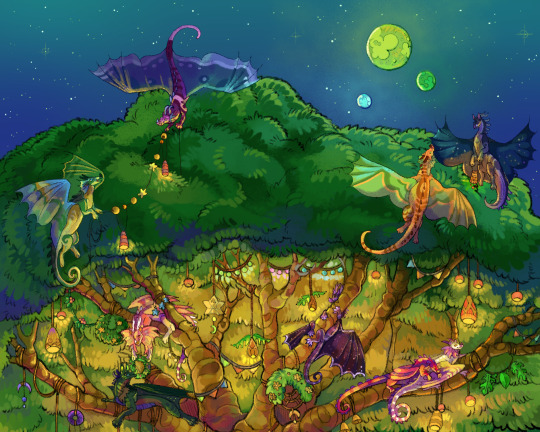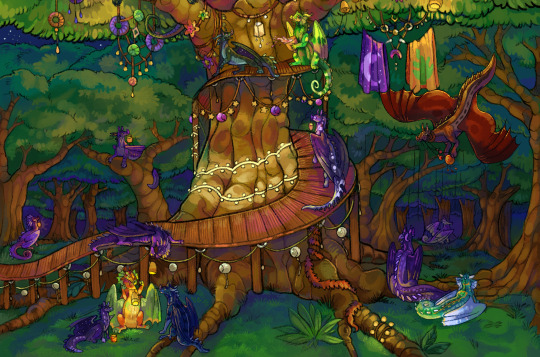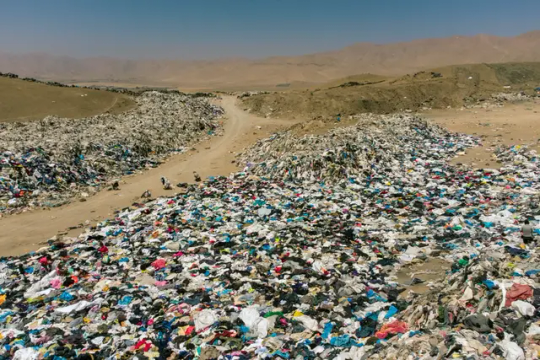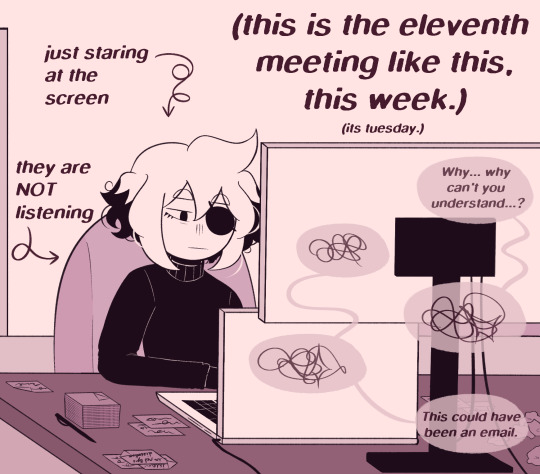#the tree continues to be
Explore tagged Tumblr posts
Text
“Our own ambitions and tasks that we set for ourselves, the frame-work we attempt to impose upon the world is no more than a shadow of a tree cast across the snow. It will change as the sun moves, be swallowed in the night, sway with the wind and when the smooth snow vanishes, it will lie distorted upon the uneven earth. But the tree continues to be.”
~ Kettricken, from Royal Assassin by Robin Hobb (1996)
#Royal Assassin#Robin Hobb#Farseer trilogy#Kettricken#quotes#quote#the best-laid schemes o' mice an' men gang aft agley#if my best-laid schemes go awry today I'll remind myself#the tree continues to be
29 notes
·
View notes
Text
i am of course now imagining sad sack tommy sitting in buck’s kitchen being asked to move into a studio loft covered in photos of his boyfriend with another man and that man’s child and well. lol
273 notes
·
View notes
Note
On my knees begging for anything trans!Obi-Wan :') love your work btw

your wish is my comand lovely anon, here's obi-wan having a nice peaceful moment training
#art requests#i got perhaps a little carried away i cant lie buuuuut im very happy with this#first thing ive really drawn in like 6 months#i came up with a silly over complicated lore for the tree in the background because .. well you gotta think about something when you draw#its a short lived species that picks a direction and grows in it until it falls over and dies and lots of smaller ones grow up in its place#and yoda plants them around the creche / training areas/ gardens / wherever and they act as a lesson in attachemnt for younglings :)#like yes this tree thats been around all your life (10 years or less) is dead but look it dying has made new trees and new opportunities#and maybe sometimes he gifts them to younglings he likes or ones he thinks could use the reminder sometimes that things ending isnt the end#new stuff happens after everything continues its all fine#anakin definitely recieved one or ten#probably was still recieving them into knighthood because yoda is a troll#he doesnt know theyre supposed to collapse and die though he just thinks hes really bad at looking after plants#anyways#yep#done with that#my art <3#cal draws#obiwan kenobi#trans obi wan#trans obi wan kenobi#trans! obiwan#star wars#star wars fanart#fanart
277 notes
·
View notes
Text






👁️👄👁️.
#hidden agenda#hidden agenda ep8#joongdunk#jokezo#joke x zo#joong archen#dunk natachai#gmmtv#thai bl#bl drama#yo.....#ngl im losing my mind a little bit over this#zo: im not ready#also zo: continues to climb joke like a tree#jkdshjkfgdf#tee briefing JD before this scene: okay listen......these bitches have only friends airing 24 hours before us#so yall HAVE to bring your A game
2K notes
·
View notes
Text

Starting off the new year with I think the most background heavy piece I've ever made! I think Rainwings and Nightwings would celebrate their traditional holidays together after the events of The brightest night. So this drawing is meant to show their cultures kind of blending together during a very joyful time. I remember talking about this concept with someone on tumblr a year ago but when I went back through my posts I couldn't for the life of me find it - so if your reading this, I remember you and this drawing stems from that conversation so thank you!
Close-ups:


#They are celebrating the brightest night that's why there's so much moon symbolism in the decorations#I hope I translated my thoughts well enough so you can get the vibe of their celebration#I was split between drawing a tree glows from the lights that were hung up upon it#or a night rave with neon lights#because I think those two situations would result from blending nightwing and rainwing cultures together#also I wanted to show this like organised chaos of the different decoration styles of both rainwings and nightwings on the tree#Moon and Kinkajou are there too!#also you don't see the spearmaster looking nightwing#it just kind of came out looking like them? by accident#continuing my weird obsession with drawing giant trees I have to draw one every year so I might as well just check that now#wings of fire#wof#nighwing#rainwing#moonwatcher wof#kinkajou wof#dragon#art#cinnamon's doodles
789 notes
·
View notes
Text
The Real Cost of the Fashion Industry

Atacama Desert, in Alto Hospicio, Iquique, Chile. (source)
The textile industry is destroying the world. The industry is wasting massive amounts of energy and materials, and polluting the air, the ground and the water supplies. It overwhelmingly exploits it's labour and extracts wealth from colonized countries, especially in Asia. I assume we all broadly understand this, but I think it's useful to have it all laid out in front of you to see the big picture, the core issues causing this destruction and find ways how to effectively move forward.
The concerning trend behind this ever-increasing devastation are shortening of trend cycles, lowering clothing prices and massive amount of wasted products. Still in year 2000 it was common for fashion brands to have two collections per year, while now e.g. Zara produces 24 collections and H&M produces 12-16 collections per year. Clothing prices have fallen (at leas in EU) 30% from 1996 to 2018 when adjusted to inflation, which has contributed to the 40% increase in clothing consumption per person between 1996 and 2012 (in EU). (source) As the revenue made by the clothing industry keep rising - from 2017 to 2021 they doubled (source) - falling prices can only be achieved with increasing worker exploitation and decreasing quality. I think the 36% degrees times clothing are used in average during the last 15 years (source) is a clear indication on the continuing drop in quality of clothing. Clothing production doubled between 2000 and 2015, while 30% of the clothes produced per year are never sold and are often burned instead (source), presumably to prevent the returns from falling due to oversupply.
These all factors are driving people to overconsume. While people in EU keep buying more clothes, they haven't used up to 50% of the clothes in their wardrobe for over a year (source). This overconsumption is only made much worse by the new type of hyper fast fashion companies like SHEIN and Temu, which are using addictive psychological tactics developed by social media companies (source 1, source 2). They are cranking up all those concerning trends I mentioned above.
Under the cut I will go through the statistics of the most significant effects of the industry on environment and people. I will warn you it will be bleak. This is not just a fast fashion problem, basically the whole industry is engaging in destructive practices leading to this damage. Clothing is one of those things that would be actually relatively easy to make without massive environmental and human cost, so while that makes the current state of the industry even more heinous, it also means there's hope and it's possible to fix things. In the end, I will be giving some suggestions for actions we could be doing right now to unfuck this mess.
Carbon emissions
The textile industry is responsible for roughly 10% of the global CO2 emissions, more than aviation and shipping industry combined. This is due to the massive supply chains and energy intensive production methods of fabrics. Most of it can be contributed to the fashion sector since around 60% of all the textile production is clothing. Polyester, a synthetic fiber made from oil which accounts for more than half of the fibers used in the textile industry, produces double the amount of carbon emissions than cotton, accounting for very large proportions of all the emissions by the industry. (source 1, source 2)
Worker exploitation
Majority of the textiles are produced in Asia. Some of the worst working conditions are in Bangladesh, one of the most important garment producers, and Pakistan. Here's an excerpt from EU Parliament's briefing document from 2014 after the catastrophic Rana Plaza disaster:
The customers of garment producers are most often global brands looking for low prices and tight production timeframes. They also make changes to product design, product volume, and production timeframes, and place last-minute orders without accepting increased costs or adjustments to delivery dates. The stresses of such policies usually fall on factory workers.
The wage exploitation is bleak. According to the 2015 documentary The True Cost less than 2% of all garment factory workers earned a living wage (source). Hourly wages are so low and the daily quotas so high, garment workers are often forced through conditions or threats and demand to work extra hours, which regularly leads to 10-12 hour work days (source) and at worst 16 hour workdays (source), often without days off. Sometimes factories won't compensate for extra hours, breaching regulations (source).
Long working hours, repetitive work, lack of breaks and high pressure leads to increased risks of injuries and accidents. Small and even major injuries are extremely common in the industry. A study in three factories in India found that 70% of the workers suffered from musculosceletal symptoms (source). Another qualitative study of female garment workers and factory doctors in Dhaka found that long hours led to eye strain, headaches, fatigue and weight loss in addition to muscular and back pains. According to the doctors interviewed, weight loss was common because the workers work such long hours without breaks, they didn't have enough time to eat properly. (source) Another study in 8 factories in India found that minor injuries were extremely common and caused by unergonomic work stations, poor organization in the work place and lack of safety gear, guidelines and training (source). Safety precautions too are often overlooked to cut corners, which periodically leads to factory accidents, like in 2023 lack of fire exists and fire extinguishers, and goods stacked beyond capacity led to a factory fire in Pakistan which injured dozens of workers (source) or like in 2022 dangerous factory site led to one dead worker and 9 injured workers (source).
Rana Plaza collapse in 2013 is the worst industrial accident in recent history. The factory building did not have proper permits and the factory owner blatantly ignored signs of danger (other businesses abandoned the building a day before the collapse), which led to deaths of 1 134 workers and injuries to 2 500 workers. The factory had or were at the time working for orders of at least Prada, Versace, Primark, Walmart, Zara, H&M, C&A, Mango, Benetton, the Children's Place, El Corte Inglés, Joe Fresh, Carrefour, Auchan, KiK, Loblaw, Bonmarche and Matalan. None of the brands were held legally accountable for the unsafe working conditions which they profited off of. Only 9 of the brands attended a meeting to agree on compensation for the victim's families. Walmart, Carrefour, Auchan, Mango and KiK refused to sight the agreement, it was only signed by Primark, Loblaw, Bonmarche and El Corte Ingles. The compension these companies provided was laughable though. Primemark demanded DNA evidence that they are relatives of one of the victims from these struggling families who had lost their often sole breadwinner for a meager sum of 200 USD (which doesn't even count for two months of living wage in Bangladesh (source)). This obviously proved to be extremely difficult for most families even though US government agreed to donate DNA kits. This is often said to be a turning point in working conditions in the industry, at least in Bangladesh, but while there's more oversight now, as we have seen, there's clearly still massive issues. (source 1, source 2)
One last major concern of working conditions in the industry I will mention is the Xinjiang raw cotton production, which is likely produced mainly with forced labour from Uighur concentration camps, aka slave labour of a suspected genocide. 90% of China's raw cotton production comes from Xinjiang (source). China is the second largest cotton producer in the world, after India, accounting 20% of the yearly global cotton production (source).
Pollution
Synthetic dyes, which synthetic fibers require, are the main cause of water pollution caused by the textile industry, which is estimated to account for 20% of global clean water pollution (source). This water pollution by the textile industry is suspected of causing a lot of health issues like digestive issues in the short term, and allergies, dermatitis, skin inflammation, tumors and human mutations in the long term. Toxins also effect fish and aquatic bacteria. Azo dyes, one of the major pollutants, can cause detrimental effects to aquatic ecosystems by decreasing photosynthetic activity of algae. Synthetic dyes and heavy metals also cause large amounts of soil pollution. Large amounts of heavy metals in soil, which occurs around factories that don't take proper environmental procautions, can cause anaemia, kidney failure, and cortical edoem in humans. That also causes changes in soil texture, decrease in soil microbial diversity and plant health, and changes in genetic structure of organisms growing in the soil. Textile factory waste water has been used for irrigation in Turkey, where other sources of water have been lacking, causing significant damage to the soil. (source)
Rayon produced through viscose process causes significant carbon disulphide and hydrogen sulphide pollution to the environment. CS2 causes cardiovascular, psychiatric, neuropsychological, endocrinal and reproductive disorders. Abortion rates among workers and their partners exposed to CS2 are reported to be significantly higher than in control groups. Many times higher amounts of sick days are reported for workers in spinning rooms of viscose fiber factories. China and India are largest producers of CS2 pollution, accounting respectively 65.74% and 11,11% of the global pollution, since they are also the major viscose producers. Emission of CS2 has increased significantly in India from 26.8 Gg in 2001 to 78.32 Gg in 2020. (source)
Waste
The textile industry is estimated to produce around 92 million tons of textile waste per year. As said before around 30% of the production is never sold and with shortening lifespans used the amount of used clothing that goes to waster is only increasing. This waste is large burned or thrown into landfills in poor countries. (source) H&M was accused in 2017 by investigative journalists of burning up to 12 tonnes of clothes per year themselves, including usable clothing, which they denied claiming they donated clothing they couldn't sell to charity instead (source). Most of the clothing donated to charity though is burned or dumbed to landfills (source).
Most of the waste clothing from rich countries like European countries, US, Australia and Canada are shipped to Chile (source) or African countries, mostly Ghana, but also Burkina Faso and Côte d'Ivoire (source). There's major second-hand fashion industries in these places, but most of the charity clothing is dumbed to landfills, because they are in such bad condition or the quality is too poor. Burning and filling landfills with synthetic fabrics with synthetic dyes causes major air, water and soil pollution. The second-hand clothing industry also suppresses any local clothing production as donated clothing is inherently more competitive than anything else, making these places economically reliant on dumbed clothing, which is destroying their environment and health, and prevents them from creating a more sustainable economy that would befit them more locally. This is not an accident, but required part of the clothing industry. Overproduction let's these companies tap on every new trend quickly, while not letting clothing the prices in rich countries drop so low it would hurt their profits. Production is cheaper than missing a trend.
Micro- and nanoplastics
There is massive amounts of micro- and nanoplastics in all of our environment. It's in our food, drinking water, even sea salt (source). Washing synthetic textiles accounts for roughly 35% of all microplastics released to the environment. It's estimated that it has caused 14 million tonnes of microplastics to accumulate into the bottom of the ocean. (source)
Microplastics build up into the intestines of animals (including humans), and have shown to probably cause cause DNA damage and altered organism behavior in aquatic fauna. Microplastics also contain a lot of the usual pollutants from textile industry like synthetic dyes and heavy metals, which absorb in higher quantities to tissues of animals through microplastics in the intestines. Studies have shown that the adverse effect are higher the longer the microplastics stay in the organism. The effects cause major risks to aquatic biodiversity. (source) The health effects of microplastics to humans are not well known, but studies have shown that they could have adverse effects on digestive, respiratory, endocrine, reproductive and immune systems. (source)
Microplastics degrade in the environment even further to nanoplastics. Nanoplastic being even smaller are found to enter blood circulation, get inside cells and cross the blood-brain barrier. In fishes they have been found to cause neurological damage. Nanoplastics are also in the air, and humans frequently breath them in. Study in office buildings found higher concentration of nanoplastics in indoor air than outdoor air. Inside the nanoplastics are likely caused mostly by synthetic household textiles, and outdoors mostly by car tires. (source) An association between nanoplastics and mitochondrial damage in human respiratory cells was found in a recent study. (source)
Micro and nano plastics are also extremely hard to remove from the environment, making it even more important that we reduce the amount of microplastics we produce as fast as possible.
What can we do?
This is a question that deserves it's own essays and articles written about it, but I will leave you with some action points. Reading about these very bleak realities can easily lead to overwhelming apathy, but we need to channel these horrors into actions. Whatever you do, do not fall into apathy. We don't have the luxury for that, we need to act. These are industry wide problems, that simply cannot be fixed by consumerism. Do not trust any clothing companies, even those who market themselves as ethical and responsible, always assume they are lying. Most of them are, even the so called "good ones". We need legislation. We cannot allow the industry to regulate itself, they will always take the easy way out and lie to their graves. I will for sure write more in dept about what we can do, but for now here's some actions to take, both political and individual ones.
Political actions
Let's start with political actions, since they will be the much more important ones. While we are trying to dismantle capitalism and neocolonialism (the roots of these issues), here's some things that we could do right now. These will be policies that we should be doing everywhere in the world, but especially rich countries, where most of the clothing consumption is taking place. Vote, speak to others, write to your representative, write opinion pieces to your local papers, engage with democracy.
Higher requirements of transparency. Right now product transparency in clothing is laughably low. In EU only the material make up and the origin country of the final product are required to be disclosed. Everything else is up to the company. Mandatory transparency is the only way we can force any positive changes in the production. The minimum of transparency should be: origin countries of the fibers and textiles in the product itself; mandatory reports of the lifecycle emissions; mandatory reports of whole chain of production. Right now the clothing companies make their chain of production intentionally complex, so they have plausible deniability when inevitably they are caught violating environmental or worker protection laws (source). They intentionally don't want to be able to track down their production chain. Forcing them to do so anyway would make it very expensive for them to keep up this unnecessarily complex production chain. These laws are most effective when put in place in large economies like EU or US.
Restrictions on the use of synthetic fibers. Honestly I think they should be banned entirely, since the amount of microplastics in our environment is already extremely distressing and the other environmental effects of synthetic fibers are also massive, but I know there are functions for which they are not easily replaced (though I think they can be replaces in those too, but that's a subject of another post), so we should start with restrictions. I'm not sure how they should be specifically made, I'm not a law expert, but they shouldn't be used in everyday textiles, where there are very easy and obvious other options.
Banning viscose. There are much better options for viscose method that don't cause massive health issues and environmental destruction where ever it's made, like Lyocell. There is absolutely no reason why viscose should be allowed to be sold anywhere.
Governmental support for local production by local businesses. Most of the issues could be much more easily solved and monitored if most clothing were not produced by massive global conglomerations, but rather by local businesses that produce locally. All clothing are made by hand, so centralizing production doesn't even give it advantage in effectiveness (only more profits for the few). Producing locally would make it much more easier to enforce regulations and it would reduce production chains, making production more effective, leaving more profits into the hands of the workers and reducing emissions from transportation. When the production is done by local businesses, the profits would stay in the producing country and they could be taxed and utilized to help the local communities. This would be helpful to do in both exploited and exploiter countries. When done in rich countries who exploit poorer ones, it would reduce the demand for exploitation. In poor countries this is not as easily done, since poor means they don't have money to give around, but maybe this could be a good cause to put some reparations from colonizers and global corporations, which they should pay.
Preventing strategic accounting between subsidiaries and parent companies. Corporate law is obviously not my area of expertise, but I know that allowing corporations to move around the accounting of profits and losses between subsidiaries and parent companies in roughly 1980s, was a major factor in creating this modern global capitalist system, where corporations can very easily manipulate their accounting to utilize tax heavens and avoid taxes where they actually operate, which is how they are upholding this terrible system and extracting the profits from the production countries. How specifically this would be done I can't tell because again I know shit about corporate law, so experts of that field should plan the specifics. Overall this would help deal with a lot of other problems than just the fashion industry. Again for it to be effective a large economic area like EU or US should do this.
Holding companies accountable for their whole chain of production. These companies should be dragged to court and made to answer for the crimes they are profiting of off. We should put fear back into them. This is possible. Victims of child slavery are already doing this for chocolate companies. If it's already not how law works everywhere, the laws should be changed so that the companies are responsible even if they didn't know, because it's their responsibility to find out and make sure they know. They should have been held accountable for the Rana Plaza disaster. Maybe they still could be. Sue the mother fuckers. They should be afraid of us.
Individual actions
I will stress that the previous section is much more important and that there's no need to feel guilty for individual actions. This is not the fault of the average consumer. Still we do need to change our relationship to fashion and consumption. While it's not our fault, one of the ways this system is perpetuated, is by the consumerist propaganda by fashion industry. And it is easier to change our own habits than to change the industry, even if our own habits have little impact. So these are quite easy things we all could do as we are trying to do bigger change to gain some sense of control and keep us from falling to apathy.
Consume less. Better consumption will not save us, since consumption itself is the problem. We consume too much clothing. Don't make impulse purchases. Consider carefully weather you actually need something or if you really really want it. Even only buying second-hand still fuels the industry, so while it's better than buying new, it's still better to not buy.
Take proper care of your clothing. Learn how to properly wash your clothing. There's a lot of internet resources for that. Never wash your wool textiles in washing machine, even if the textile's official instructions allow it. Instead air them regularly, rinse them in cool water if they still smell after airing and wash stains with water or small amount of (wool) detergent. Never use fabric softener! It damages the fabrics, prevents them from properly getting clean and is environmentally damaging. Instead use laundry vinegar for making textiles softer or removing bad smells. (You can easily make laundry vinegar yourself too from white vinegar and water (and essential oils, if you want to add a scent to it) which is much cheaper.) Learn how to take care of your leather products. Most leather can be kept in very good condition for a very long time by occasional waxing with beeswax.
Use the services of dressmakers and shoemakers. Take your broken clothing or clothing which doesn't fit anymore to your local dressmaker and ask them if they can do something about it. Take your broken and worn leather products to your local shoemaker too. Usually it doesn't cost much to get something fixed or refitted and these expert usually have ways to fix things you couldn't even think of. So even if the situation with your clothing or accessory seems desperate, still show it to the dressmaker or shoemaker.
If it's extremely cheap, don't buy it. Remember that every clothing is handmade. Only a small fraction of the cost of the clothing will be paying the wages of the person who made it with their hands. If a shirt costs 5 euros (c. 5,39 USD), it's sewer was only payed mere cents for sewing it. I'm not a quick sewer and it takes me roughly 1-2 hours to cut, prepare and sew a simple shirt, so I'm guessing it would take around half an hour to do all that for a factory worker on a crunch, at the very least 15 minutes. So the hourly pay would still be ridiculously low. However, as I said before, the fact that the workers in clothing factories get criminally low pay is not the fault of the consumer, so if you need a clothing item, and you don't have money to buy anything else than something very cheep, don't feel guilty. And anyway expensive clothing in no way necessarily means reasonable pay or ethical working conditions, cheep clothing just guarantee them.
Learn to recognize higher quality. In addition to exploitation, low price also means low quality, but again high price doesn't guarantee high quality. High quality allows you to buy less, so even if it's not as cheep as low quality, if you can afford it, when you need it, it will be cheaper in long run, and allows you to consume less. Check the materials. Natural fibers are your friends. Do not buy plastic, if it's possible to avoid. Avoid household textiles from synthetic fibers. Avoid textiles with small amounts of spandex to give it stretch, it will shorten the lifespan of the clothing significantly as the spandex quickly wears down and the clothing looses it's shape. Also avoid clothing with rubber bands. They also loose their elasticity very quickly. In some types of clothing (sport wear, underwear) these are basically impossible to avoid, but in many other cases it's entirely possible.
Buy from artisans and local producers, if you can. As said better consumption won't fix this, but supporting artisans and your local producers could help keep them afloat, which in small ways helps create an alternative to the exploitative global corporations. With artisans especially you know the money goes to the one who did the labour and buying locally means less middlemen to take their cut. More generally buy rather from businesses that are located to the same country where the production is, even if it's not local to you. A local business doesn't necessarily produce locally.
Develop your own taste. If you care about fashion and style, it's easy to fall victim to the fashion industry's marketing and trend cycles. That's why I think it's important to develop your personal sense of style and preferences. Pay attention at what type of clothes are comfortable to you. Go through your wardrobe and track for a while which clothing you use most and which least. Understanding your own preferences helps you avoid impulse buying.
Consider learning basics of sewing. Not everyone has the time or interest for this, but if you in anyway might have a bit of both, I suggest learning some very simple and basic mending and reattaching a button.
Further reading on this blog: How to see through the greenwashing propaganda of the fashion industry - Case study 1: Shein
Bibliography
Academic sources
An overview of the contribution of the textiles sector to climate change, 2022, L. F. Walter et al., Frontiers in Environmental Science
How common are aches and pains among garment factory workers? A work-related musculoskeletal disorder assessment study in three factories of south 24 Parganas district, West Bengal, 2021, Arkaprovo Pal et al., J Family Med Prim Care
Sewing shirts with injured fingers and tears: exploring the experience of female garment workers health problems in Bangladesh, 2019, Akhter, S., Rutherford, S. & Chu, C., BMC Int Health Hum Rights
Occupation Related Accidents in Selected Garment Industries in Bangalore City, 2006, Calvin, Sam & Joseph, Bobby, Indian Journal of Community Medicine
A Review on Textile and Clothing Industry Impacts on The Environment, 2022, Nur Farzanah Binti Norarmi et al., International Journal of Academic Research in Business and Social Sciences
Carbon disulphide and hydrogen sulphide emissions from viscose fibre manufacturing industry: A case study in India, 2022, Deepanjan Majumdar et al., Atmospheric Environment: X
Microplastics Pollution: A Brief Review of Its Source and Abundance in Different Aquatic Ecosystems, 2023, Asifa Ashrafy et al., Journal of Hazardous Materials Advances
Health Effects of Microplastic Exposures: Current Issues and Perspectives in South Korea, 2023, Yongjin Lee et al., Yonsei Medical Journal
Nanoplastics and Human Health: Hazard Identification and Biointerface, 2022, Hanpeng Lai, Xing Liu, and Man Qu, Nanomaterials
Other sources
The impact of textile production and waste on the environment (infographics), 2020, EU
Chile’s desert dumping ground for fast fashion leftovers, 2021, AlJazeera
Fashion - Worldwide, 2022 (updated 2024), Statista
Fashion Industry Waste Statistics & Facts 2023, James Evans, Sustainable Ninja (magazine)
Everything You Need to Know About Waste in the Fashion Industry, 2024, Solene Rauturier, Good on You (magazine)
Textiles and the environment, 2022, Nikolina Šajn, European Parliamentary Research Service
Help! I'm addicted to secondhand shopping apps, 2023, Alice Crossley, Cosmopolitan
Addictive, absurdly cheap and controversial: the rise of China’s Temu app, 2023, Helen Davidson, Guardian
Workers' conditions in the textile and clothing sector: just an Asian affair? - Issues at stake after the Rana Plaza tragedy, 2014, Enrico D'Ambrogio, European Parliamentary Research Service
State of The Industry: Lowest Wages to Living Wages, The Lowest Wage Challenge (Industry affiliated campaign)
Fast Fashion Getting Faster: A Look at the Unethical Labor Practices Sustaining a Growing Industry, 2021, Emma Ross, International Law and Policy Brief (George Washington University Law School)
Dozens injured in Pakistan garment factory collapse and fire, 2023, Hannah Abdulla, Just Style (news media)
India: Multiple factory accidents raise concerns over health & safety in the garment industry, campaigners call for freedom of association in factories to ‘stave off’ accidents, 2022, Jasmin Malik Chua, Business & Human Rights Resource Center
Minimum Wage Level for Garment Workers in the World, 2020, Sheng Lu, FASH455 Global Apparel & Textile Trade and Sourcing (University of Delaware)
Rana Plaza collapse, Wikipedia
Buyers’ compensation for Rana Plaza victims far from reality, 2013, Ibrahim Hossain Ovi, Dhaka Tribune (news media)
World cotton production statistics, updated 2024, The World Counts
Dead white man’s clothes, 2021, Linton Besser, ABC News
#fashion#fashion industry#sustainability#sustainable fashion#sustainable clothing#environment#climate change#i will be continuing the series of how to see through fashion industry propaganda at some point#i just felt compelled to write this because i feel like people so often miss the forest for the trees in this conversation
505 notes
·
View notes
Text

'i asked him if he was a tough guy, he said not really' he didn't even have it in him to LIE & claim to be tough. thank god he's self aware. i cant believe he owned up to something he very much should have lied about in this situation & they killed him later in the game anyway. of all the ty dellandreas in the world he really is the ty dellandrea-est.
#sharks lb#hockey#sharks#ty dellandrea#spiritually he is continually getting the football yanked from under him & picking the sad christmas tree. do you all understand this.#tweet linked in the body of the post where i quote the quote from the tweet because the link under the tweet is the hockeyfights page#i also do not know why i didn't do it the other way around <3
135 notes
·
View notes
Note
For the shipaganza
What if...
what if Coo and Starflung had a slumber party? Where they stargaze and do fun slumber party stuff? They deserve it (not forced ofc!!!)
you're right! i think they deserve it, too!

*✩˚ʚ♡ɞ˚ valentines shipaganza masterpost ✩˚ʚ♡ɞ˚ ⋆˙⟡
#my art#starstruck dee#coo kirby#🎀💖#COOSTRUCK NATION...!! RISE!! RISE!!!!!!!!!!! 🥳🥳🥳🥳🥳#glad to see people are still a little into this one!! they are Very Soft 🥺#i think he has still not made any effort to openly communicate the crush he has going on#(not that she'd understand anyway)#and frankly he would rather perish than let anybody else know about this either#coo really putting the “pine” into pine trees#also though i would not typically trust starstruck with baking these cookies ARE to his tastes!! full of bugs!! yum yum!#they're not “gross”; that's not the issue! he's just flustered because for many birds this is a Thing™️. courtship feeding!!#he knows starstruck doesn't know so he's not reading into it (much) & he'll be super normal about it (trust) & won't dwell on it (at all)#once again bringing my birdtism to the coo enjoyers here on tumblr dot com#oh actually i do want to say that the stripes on the wings- while typical of owls- were not in my design for him previously!!#inspired to include them by veveisveryuncool's realistic animal friends design of him!!#anyway.... melancholy romantic saga about an owl and a circle continues.#guy gardens in his tree! that's his backyard. kinda think he might've cultivated all that pinkpurple wisteria there just for her
104 notes
·
View notes
Note

you must never give up on homestuck animal crossing
!!!!!!!!
AS FORETOLD BY THE ANCIENT MURALS (pictures i drew like 10 years ago)!!!!!!
wait im gonna go find them one sec
YEAH!!!
YEAEAEAEAEA HAHAHAH


this is from 11 years ago how wild is that..
time passes.. i am nostalgic..
#hs#one fun detail ive noticed as i continue to age is that sometimes you can actually recall what it felt like while working on certain pieces#even if u made them forever ago!#this is actually one of them.. the leaves on the trees gave me all sorts of trouble and i redrew dave's expression in the 2nd pic like..#10 times until i was satisfied with it#i saved the clouds for last because painting clouds was always my favourite part!!#weeeee memories#binask
87 notes
·
View notes
Text


All I want for Christmas isssssssssss to completely demolish your chances of winning another championship~
+

without text, and the lineart I really like:




plus some of my inspos:



and if only I wasn't a coward....

#i like to imagine this is some fia mandated community service for fernando and seb shows up to annoy the fuck out of him#seb: ive been a real naughty boy this year santa 😏 will you spank me instead of giving me coal?#fernando: 😐😐😐 this is supposed to be a children's event.#*proceeds to fall for seb's teasing regardless*#rip all the kids but santa is gonna be real busy for the next couple hours....#glad to continue my streak of only drawing modern fanart if its absurd in some way >:)#i am very proud of these hello :)#merry christmas!!! and a happy vettonso to you :D#please imagine these as waking up to santa having left gifts under the tree...fernanda claus....#i need to stop calling every work my best work though djfjkf its just regency bias#but idk what spurred me to draw all this in like. one day basically. considering i havent even drawn much since finals#im like haha wouldnt it be funny to draw topical fanart. fernando DID wear that santa suit one tim- oh my god#except it does mean i had to draw nando claus in a sexy pose which is um. interesting#but gaaaaahhhhh i really love these hahaha so hilarious to me. also wow as i said...relevant fanart for once so crazy#sebastian vettel#fernando alonso#sv5#fa14#vettonso#sebnando#catie.art.#f1#formula 1
62 notes
·
View notes
Text

[reverse entry AU]
so glad the work week is over!
no more meetings!
what do you mean its only tuesday.
#isat#in stars and time#isat siffrin#reverse entry au#isat modern office au#isat spoilers#<- not REALLY but its blink and u miss it tbh#and is hardly legible#and probably doesnt make much sense as a spoiler for regular isat tbf#its more of a spoiler if u know the spoiler from isat to begin with????????#i think i am starting to confuse myself on if this is really a spoiler ASFASDAFRA#inspired by my week so far thumbs up#sometimes u end up in too many meetings about the same subject and wonder why you are even here#proceed to zone out till hear key words#tune in and respond#then continue zoning out#omg just like beloved indie game in stars and timeeeee#for legal reasons that is an exaggerated explanation to further enhance the joke thumbs up part 2#alternative takes that build on this same idea include#staring at computer screen in general trying to remember what you were doing#or silently judging a computer program for freezing on you for the seventh time in the past twenty minutes#or just staring blankly at the screen in general as people do yanno thumbs up part 3#oh also to note yea this is not in the office lmao#modern times means sometimes you also get to have wfh days yippeeee so siffrin is in his apartment#the star is probably sitting in the kitchen next to the flavor tree at this moment in time dont worry about it aha#WAIT i just realized i forgor the shine in siffrins eyes OOPS#actually wait nvm this is fine it adds to this i think HAHAHA#okay tag talk over !!!!
152 notes
·
View notes
Text

colored something from a little while ago
#ocs#moxie#thalia#having thoughts abt them#i feel like i view their situationship from thalia's pov when looking at it because i tend to project on her more and this makes me like.#portray her as being the more unfortunate one in it But you know what IT TAKES TWO she's aware it isn't that good for her#but she likes it too much so even if she's so latched onto moxie despite not having the need for commitment reciprocated towards her#she's still actively making the choice to continue this instead of moving on#moxie is essentially leading her on but thalia is letting herself be lead on she's letting moxie use her#my sweet tree flesh girl
74 notes
·
View notes
Text

Commission for @skelekins! :3
Tis the start of an rp between us where Crack's au died, and he was all that was left, and he ends up in the Omega Timeline after being found by a specific colorful skeleton. :>
(Comms not open atm, but may be opening soon.)
#pov you'r Fresh and you found a large sad man all alone in a white void#and you decide to lean him against a tree in the omega timeline and continue on with your day#your daily good deed done#surely just leaving a starved horror sans in a park where humans walk around is a good idea#surely that yellow ball of positivity will notice and deal with him#anyways#crack sans#horror tourette's sans#horror sans#horrortale#undertale#utmv#didderd art#art commission#it's fine. another horror monster found him before he woke up#he's being taken care of#and falling hard for his care taker
137 notes
·
View notes
Text
Yeah, college is different breed entirely and I've been preoccupied with personal D&D stuff too. That explains why I've been inactive with posts lately,
BUT-

The release of Dead Trees made me want to make art for my girl 🥺 (despite it being in the middle of exams) As always she looks gorgeous in the official arts that she's been in.
And as a person who's read the CM Alpha, the song encapsulates her so well and it just made me love Farryn even more.
The doomed yuri is so real with this one. She deserves happiness, her and Gwenna 😔
I want her back man, I yearn for her return everyday 🙏
#i continue to yearn for her#art#legend of avantris#legend of avantris fanart#edge of midnight#eom#farryn of the hartsblight#gorthos#beast of blight#dead trees
41 notes
·
View notes
Note
I swear the next time you turn your back on the erins there going to find a new way to make the family tree worse somehow ... That or drag the tribe back into the plot
Every time I turn my back, Moonpaw Discourse happens, so I must never turn my back ever again. We're on lockdown on Bonefall.tumblr.co.uk
#fennelposting#my ass failed to continue to read star btw I got sucked back into family tree stuff#im so close
93 notes
·
View notes
Text
Why are ppl scared to call it what it is and say we’re still going thru covid on top of seasonal illness. Like. That’s pretty important right. I was watching the news and they were like oh yeah we have an unprecedented number of flu cases “as well as other sicknesses” without actually saying Covid. No announcement abt vaccinations or masking or anything. Also if I hear someone joking abt “war flashbacks” for mentioning covid I fucking hate u
#source: most of my family members are nurses and it was so bad for one of them they had to be put on a ventilator. in the hospital they#worked at. looking back I think I had a reason to feel a little offput by the shows of support early pandemic#with people tying blue ribbons around trees and lighting signs blue to support healthcare workers#I get that it was supposed to be moral support when we couldn’t do anything but follow health advisories#and it did matter to make them feel uplifted and do something than nothing. im not gonna deny that#but. you can still help now. u know that right. you still have a responsibility here#u can still mask up. u can still get vaxxed and call in sick to avoid infecting others#don’t leave it on healthcare workers to pick up the pieces just because they were doing it before. do u think they had a choice?#nobody likes picking up the slack for someone else and now that we have more tools to do smth couldn’t we just. do it????#im not a virologist but i also feel like continuing to let it get worse by letting more mutations develop#could continue to set us back since this virus is pretty good at fucking us up long term and finding new ways to do that#while there are ppl still researching covid which is STILL A RELATIVELY NEW VIRUS. and studying possible treatment and cures#yapping#vent
394 notes
·
View notes